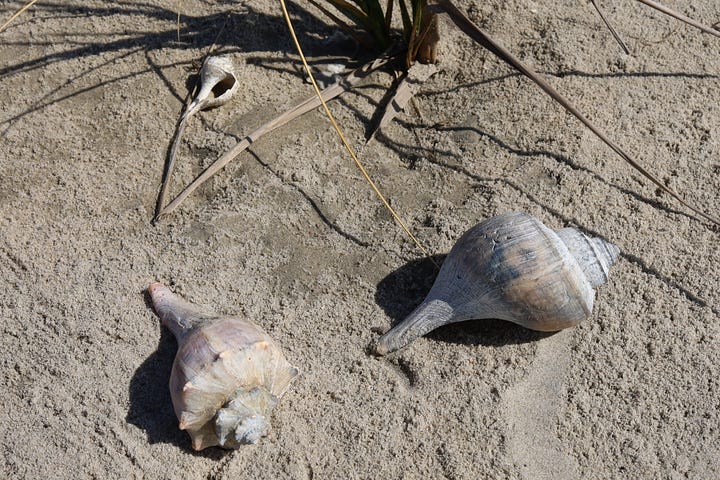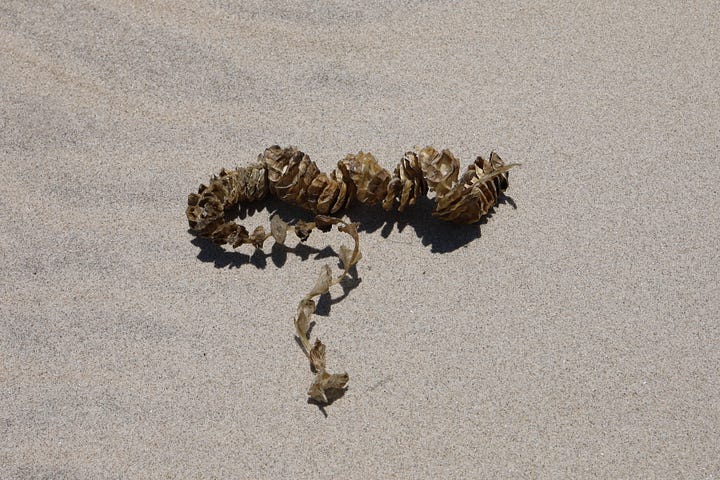#24-13 All Conched Out, Part 1 - A Surfeit of Seashells
In which the E@l searches for seashells on the seashore
My search for gold had finally paid off. I had found the motherlode, and I was surrounded by it. It was a horde much bigger than I had ever imagined. There was so much that I could afford the luxury of just choosing the best, most perfect specimens.
Gold? Oh, no, I’m not talking about common minerals. I’m talking conch shells.
If you’ve ever spent a summer day wandering along a beach, your eye is naturally drawn to all the glittery shell fragments at the edge of the tide line. And most are just that, fragments. If you are lucky, you might find the occasional intact olive shell, with its textile-brown pattern like woven flax. But inexperienced beachcombers, and most children, will pick up anything that remotely resembles a shell, and most of which are just fragments. Shell hash.
But the discerning eye selects only the best, unbroken shells, as being worthy of collection. And the dream of every intrepid beachcomber is finding the perfect, unbroken conch shell. Hold it to your ear, my mother told me, and you can hear the ocean all year long, even when it is far away.


Along beaches on the US Atlantic coast, such finds are rare, due both to development and population density. Although live conchs are abundant in our ocean waters, any conchs that wash ashore would be immediately scooped up. And heavy development in places like Ocean City and Virginia Beach has removed or homogenized all the little inlets, marshes, and tidal pools where conchs feed on clams, and stranded shells normally get trapped. Consequently, the perfect conch shell is a rare find. Unless you know where to look.
A Whelk by any Other Name
Conch is a common term for any large, predatory marine snail, most of which are properly classified as whelks. On the US Atlantic coast, three species of large conch can be found. The knobbed whelk, Busycon carica, is the most common species from Maryland south to Florida. It is easily identified by its heavy shell with large spiny knobs radiating from the upper, wider, portion of the body (the spire). The channeled whelk, Busycotypus canaliculatus, is more delicate, lacks knobs, and has a narrow groove running around the inner edge of the spire. Channeled whelks are more common north of Delaware Bay and are the most abundant species in Massachusetts. Both of these are considered “right-handed” snails, because the whorl of the shell curves toward the right, in a clockwise manner. And when you hold the shell upright (pointy end down), the opening (aperture) is on the right side, and you can insert the fingers of your right hand into the shell and curl them around the middle part (the columella). In the Mid-Atlantic region, knobbed whelks outnumber channeled whelks about 10 to 1.
Less common than both of these is the lightning whelk (either Busycon contrarium or Sinistrofulgur sinistrum, depending on locale). Lightning whelks are left-handed or sinistral, thus their scientific name. Their common name refers to the dark tan streaks along the otherwise white sides of the shell. Lightning whelks are more common in Florida and the Gulf of Mexico but constitute less than 1% of the whelks in the Mid-Atlantic region. Thus, they are a much more highly prized find in our area.
Both knobbed and channeled whelks produce long strings of egg cases, each the size of a quarter, and attached to a long, curved stalk. Beachcombers often find egg case strands, which look much like the shed skin of a snake. Each strand may contain several hundred thin, tan-colored capsules, and each capsule contains up to 50 small whelk eggs. As soon as the eggs hatch, the very hungry little snails immediately begin chowing down on their brother and sister cellmates. Eventually the few remaining survivors get large enough to chew a hole in the egg case and escape.
Juvenile conchs are easy prey for crabs and small fish. To avoid predation, they spend their early years buried in the seafloor sediments until they reach 2-3 inches in length, a size at which virtually nothing can eat them. Then, they migrate up to the sediment surface, where they hunt for clams. Grasping a clam with their large foot, they pull it against their shell to pry it open, then insert their long proboscis, which has a file-like tongue called a radula. In concert with strong enzymes, they can make short work of the soft clam meat. After such a meal, they might not eat again for a month.
Crabs Catch Conchs
While conch shells are valuable to beachcombers, the meat of the conch is a valuable seafood product. Both the knobbed and channeled whelks support fisheries along the US Atlantic Coast. Knobbed whelks are primarily fished with dredges along the southern coastal states, whereas channeled whelks are caught by trap from Maryland north into Massachusetts. While some of these are consumed locally, most are exported to markets in Asia, bringing US fishers about $3.0 million annually.
Conch were only a minor product in the northeast US before 2000. The fishery for channeled whelk has developed largely since that time due to climate change. From 1995 to 2020, lobster landings declined by over 90% in the Southern New England (SNE) region (south of Cape Cod, Massachusetts, including Connecticut and New York). This was due primarily to lobster shell disease, a bacterial infection associated with ocean warming. Lobster fishermen in that region often fished for channeled whelks in the off-season, but by 2007, many had begun “conching” full time to replace the lobstering income they had lost. The channeled whelk fishery requires bait, and the best bait, according to many fishermen, are large female horseshoe crabs. For this reason, a large fishery for horseshoe crabs has developed to supply bait for conch fishing.
But horseshoe crabs also have other important roles. The blood of horseshoe crabs is used to produce Limulus amoebocyte lysate (LAL), a valuable product used to test for the presence of bacteria in pharmaceutical products and surgical supplies (see E@L #6). A dedicated fishery captures about half a million horseshoe crabs yearly specifically for this purpose. Horseshoe crabs have an even more important role in our local ecosystem – they spawn millions of eggs every spring which are important food for migrating shorebirds, especially red knots. Both fisheries for horseshoe crabs have caused depletion of their stocks, threatening bird populations, so the horseshoe crab fishery is highly regulated.
Marshy Motivations
Much of my career was spent studying the biology of whelks for scientific purposes. The secrets and surprises of their lives will be revealed in my next post. Although I no longer study them, I still enjoy finding their shells on the beach.
A few years ago, I discovered a secret source of conch shells that is rarely visited by people. I always go there by kayak, because the route goes through some very shallow tidal channels, with only inches of water at low tide. I love going there just to immerse myself in the tidal marsh ecosystem. The creek winds its way through acres of salt marsh grass, and its banks are peppered with wild oysters. Saltwater terrapins sun themselves on the bank until they see me, then frantically throw themselves down the bank into the water to escape. Willets and oystercatchers flit through the marsh grass looking for food. Stately herons and great egrets watch me carefully, then fly up with a squawk to protest my presence. Occasionally, a black skimmer swoops by at jet speed, it’s lower bill scooping the water for fish. Their populations are highly depleted, and this is one of the few places where they can be seen.
After paddling energetically for an hour, I arrive at a spot where the creek meets the backside of the sand dunes. Here, I park my kayak in the reeds, and bury a small anchor well up above the high tide line, to ensure that my kayak doesn’t float away as the tide floods. Then, I cross the hot sand to the outer beach and begin hiking. When I come to a washover, an area where storm surges have flattened the dunes, I walk inland and start looking.
When I find a hot spot, I may be able to count over a hundred conch shells within a few yards of me. There are so many that I can have my pick of different types and colors, but I rarely collect more than a few at a time. My house is adorned with so many conch shells, both inside and out, that my wife has forbidden me from bringing home any more of them, so I mostly just give them away. I could probably sell them on Etsy for a few dollars each, but I have no mercenary intentions. I’m just addicted to collecting conch shells because I love their beauty and variety.
I only collect the most perfect specimens, and I’m always on the lookout for those with unique coloration. Some of them are recently washed ashore by storms, and still have the pink coloring inside the shell. Others may have been buried under the sand for decades, and their shells turned black by hydrogen sulfide.
Finding a conch shell on the beach is a gift, both for their beauty and rarity. But it doesn’t exist in isolation. As I hold it in my hand, its symmetrical spire begins to swirl around and expand into a spiral galaxy of social-ecological relationships. At the center is the conch; farther outward along the spiral are its predators and prey, the fishermen who catch it, the horseshoe crabs caught as bycatch and used for bait, the birds who would have eaten the horseshoe crab eggs, the diners who would eat the conch, the hospital patients whose lives may depend on medical tests using LAL, the lobsters whose demise led to an expanding conch fishery, global climate change impacts on lobster populations, humans who caused it, and finally, it collapses back upon itself, and me, the beachcomber who found the shell.
Then I put it to my ear and listen to the sea.
Writing about nature is not easy. It requires preparation, hard work, and sometimes sweat to observe nature, and time, thought, and effort to describe it. Although this post is free, becoming a paid subscriber will help me continue to share my thoughts, and encourage future postings.
Alternatively, if you would like to support my work with a one-off contribution, click “Buy me a coffee” below.






Excellent essay, I also love finding shells on beaches.
I hadn't realised there were quite so many pressures on the horseshoe crab populations.